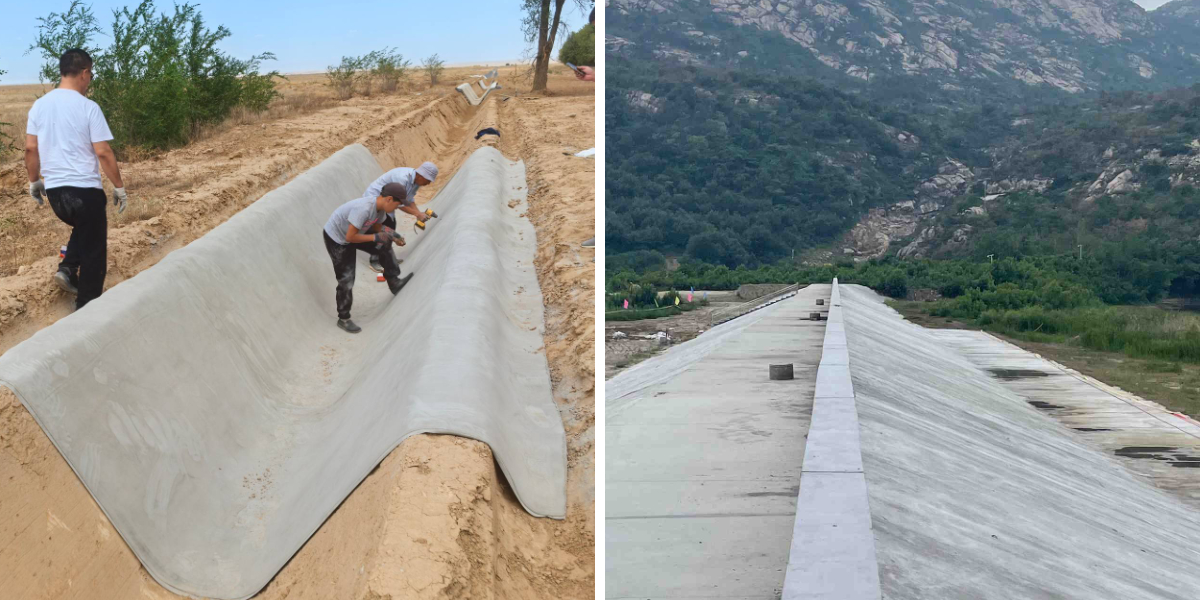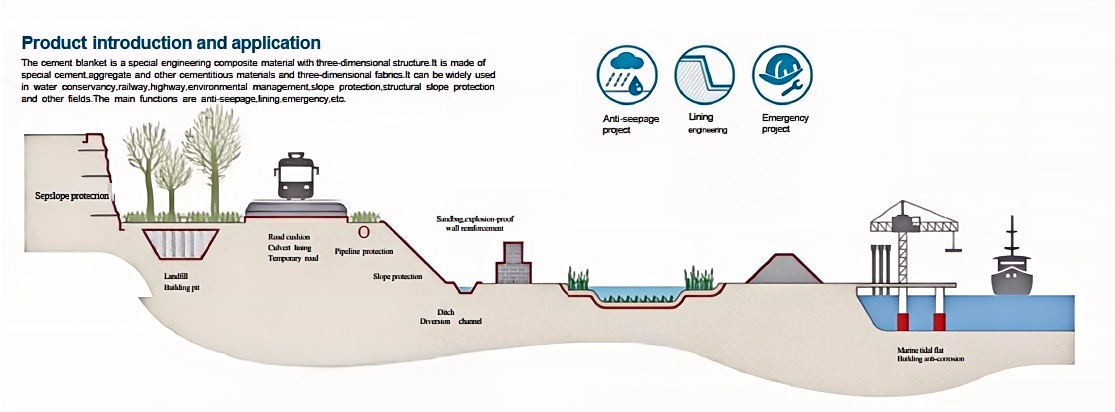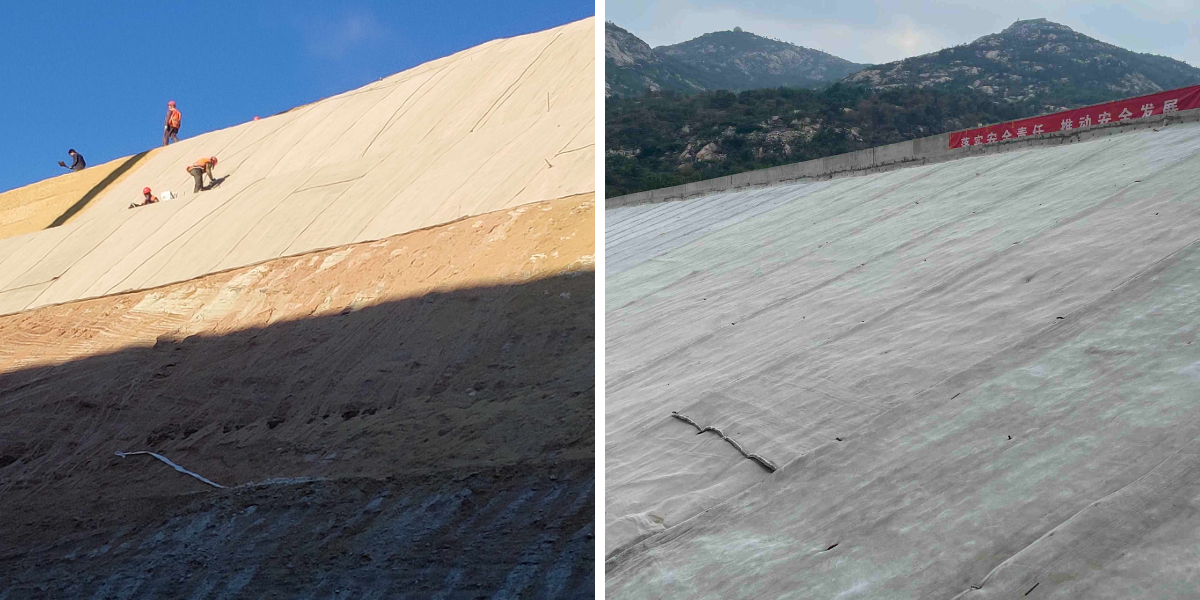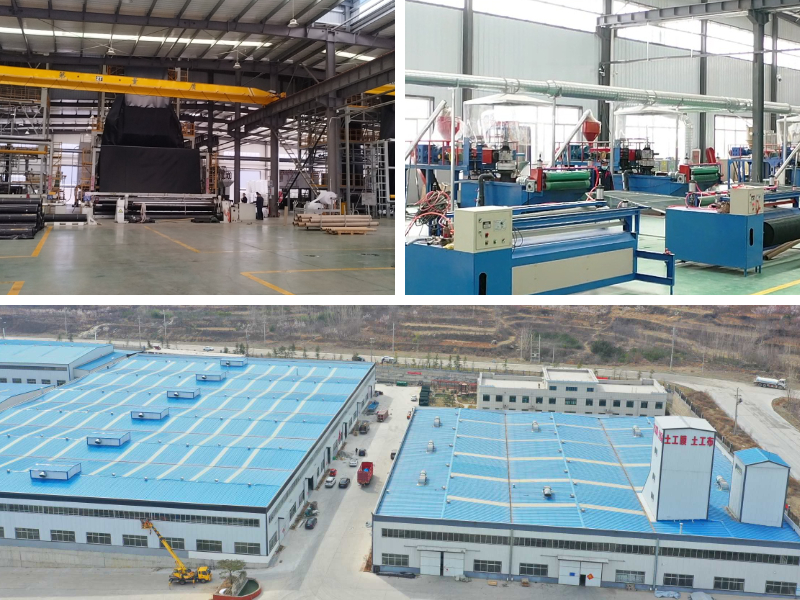How Cement Blankets Are Used in Erosion Control
Erosion is a power chance to landscapes, infrastructure, and ecosystems worldwide. From riverbanks washing away throughout heavy rains to building websites dropping topsoil, unchecked erosion can lead to expensive injury and environmental harm. Traditional erosion manage methods—such as concrete pouring, rock riprap, or artificial mats—often come with drawbacks: excessive labor costs, lengthy set up times, or constrained adaptability to uneven terrain. That’s the place cement blankets (also acknowledged as cement fabric or bendy concrete blanket) step in. These revolutionary substances mix the power of concrete with the flexibility of fabric, making them a game-changer for erosion manage tasks of all sizes. In this guide, we’ll wreck down how cement blankets work, their key applications, set up pleasant practices, and why they outperform regular solutions—with a center of attention on integrating critical phrases like cement curing blankets, cement cloth, and bendy concrete blanket to assist you apprehend their full value.
What Are Cement Blankets, and How Do They Support Erosion Control?
Before diving into usage, it’s indispensable to make clear what cement blankets are and why they’re best for erosion control. A cement blanket is a factory-manufactured cloth consisting of a durable, bendy material matrix infused with dry cementitious substances (like Portland cement, aggregates, and additives). When activated with water, the cement inner hydrates, hardening into a strong, weather-resistant layer that bonds to the underlying soil or substrate. Unlike inflexible concrete slabs, cement fabric retains sufficient flexibility at some stage in set up to conform to slopes, curves, and irregular surfaces—making it best for areas susceptible to erosion, the place uneven terrain frequently thwarts common methods.
A key issue of profitable cement blanket use is suited hydration and hardening, which is the place cement curing blankets come into play. After activating the cement blanket with water, a cement curing blanket helps hold moisture, making sure the cement hydrates evenly and reaches its full strength. Without ideal curing, the cement may also crack, weaken, or fail to face up to erosion over time—making cement curing blankets a crucial section of any mission the usage of cement material or bendy concrete blanket.
In erosion control, the core advantage of cement blankets is their capability to create a defensive barrier that:
Stops soil from being washed away by way of rain, runoff, or water currents.
Resists put on from foot traffic, machinery, or environmental elements (like freeze-thaw cycles).
Allows for vegetation boom (when the usage of permeable variants) to similarly stabilize soil and assist ecosystems.
Reduces set up time and labor in contrast to mixing and pouring on-site concrete.
Step-by-Step: How to Install Cement Blankets for Erosion Control
Installing a bendy concrete blanket for erosion manage requires cautious planning and adherence to excellent practices to make sure long-term effectiveness. Below is a detailed, project-tested process—with emphasis on how every step helps erosion resistance and why cement fabric is simpler to work with than regular materials.
1. Site Preparation: Clear and Level the Area
Before laying the cement blanket, put together the web site to get rid of limitations and create a secure base. Start by means of clearing particles (rocks, roots, trash) and trimming overgrown vegetation—this prevents gaps between the cement material and the soil, which ought to enable water to seep underneath and purpose erosion. Next, grade the place to clean out uneven spots: for slopes, make sure the floor is gently sloped (not jagged) to assist the bendy concrete blanket conform except stretching or tearing. If the soil is unfastened or sandy, compact it gently with a curler or hand device to minimize settling as soon as the cement blanket is installed.
2. Measure and Cut the Cement Blanket to Fit
Cement fabric is normally sold in rolls of various widths (2–10 feet) and lengths (50–100 feet). Measure the venture place carefully, including a 6–12 inch overlap for seams (to stop water from seeping thru gaps). Use a utility knife or heavy-duty scissors to reduce the cement blanket to size—its bendy cloth core makes reducing a ways less complicated than reducing inflexible concrete panels. For curved areas (like riverbanks or drainage ditches), make small slits alongside the part of the cement material to assist it bend barring creasing, making sure full contact with the soil.
3. Lay the Cement Blanket and Secure It
Once cut, unroll the cement blanket over the organized area, beginning from the pinnacle of slopes (to stop it from sliding down) or the upstream give up of water points (to direct runoff over the surface). Ensure the cement fabric lies flat, with no wrinkles or air pockets—use stakes (galvanized steel or plastic) to invulnerable the edges each 2–3 feet, riding them 6–8 inches into the soil. For seams, overlap the edges of adjoining cement blankets by way of at least 6 inches and invulnerable the overlap with extra stakes or water-resistant tape (to toughen the seal). This step is indispensable for erosion control: any gaps in the bendy concrete blanket can grow to be entry factors for water, undermining the barrier.
4. Activate the Cement with Water
After securing the cement blanket, set off the dry cementitious substances by using making use of water. Use a backyard hose with a spray nozzle (set to a best mist) or a low-pressure sprinkler to moist the whole floor evenly. Avoid the usage of high-pressure water, as this can wash away the cement from the material matrix. The purpose is to saturate the cement material completely—you’ll be aware of it’s activated when the cloth turns from a mild grey (dry) to a darkish grey (wet). For massive areas, work in sections to make sure no section of the bendy concrete blanket dries out earlier than hydration starts.
5. Cure the Cement Blanket with a Cement Curing Blanket
Proper curing is non-negotiable for maximizing the energy and erosion resistance of the cement blanket. After activation, cowl the moist cement fabric with a cement curing blanket—a breathable, water-retaining material that slows evaporation and maintains the cement moist. Leave the cement curing blanket in area for 7–10 days (or as advocated via the product manufacturer): this approves the cement to hydrate fully, forming a dense, crack-resistant layer. For tasks in hot, dry climates, mist the cement curing blanket each day to top off moisture; in bloodless climates, use an insulated curing blanket to defend in opposition to freezing.
6. Inspect and Finish (Optional: Add Vegetation)
Once cured, eliminate the cement curing blanket and check out the cement fabric for cracks, gaps, or free edges. Repair any troubles immediately: for small cracks, practice a cement-based patching compound; for unfastened stakes, re-drive them or add new ones. If you favor to beautify ecosystem support, pick out a permeable cement blanket and seed the floor with native grasses or groundcover—over time, the vegetation will develop thru the cement cloth, similarly stabilizing the soil and mixing the barrier with the surrounding landscape.
Key Applications: Where Cement Blankets Excel in Erosion Control
Cement material and bendy concrete blanket are versatile adequate to handle erosion manage in a huge vary of settings—from residential yards to large-scale civil engineering projects. Below are the most frequent applications, with examples of how cement blankets resolve special erosion challenges.
1. Riverbanks and Stream Beds
Rivers and streams are high ambitions for erosion, as consistent water glide wears away soil and undermines banks. Traditional options like rock riprap are heavy, expensive, and can disrupt aquatic ecosystems. Cement blankets provide a higher alternative: their flexibility lets in them to conform to the herbal curves of riverbanks, whilst their hardened floor resists scouring from fast-moving water. For movement beds, permeable cement fabric versions let water go with the flow via whilst trapping sediment—preventing the mattress from deepening and defending fish habitats. In this application, the use of a cement curing blanket is in particular important, as the steady proximity to water can wash away moisture if curing isn’t controlled.
2. Construction Site Erosion Control
Construction websites generate massive quantities of naked soil, which is distinctly prone to erosion from rain and wind. Regulatory businesses regularly require erosion manage measures to forestall sediment from washing into nearby waterways. Flexible concrete blanket is an best answer here: it can be rapidly mounted over stockpiles, uncovered slopes, or drainage channels to comprise soil. Unlike artificial erosion mats (which can degrade over time), cement material offers long-term protection—even after building ends. For example, a street building task would possibly use cement fabric to line the facets of a brief drainage ditch, stopping sediment from clogging nearby storm drains. The ease of set up (no mixing concrete on-site) additionally saves building crews time, maintaining tasks on schedule.
3. Residential and Commercial Landscaping
Homeowners and property managers regularly face erosion troubles on slopes, round protecting walls, or close to downspouts. Cement material is a low-maintenance answer for these small-scale projects: it can be mounted alongside the base of a slope to capture runoff, or round downspouts to forestall soil erosion from targeted water flow. For example, a home owner with a steep outdoor slope would possibly use a bendy concrete blanket to line the slope, then plant native vegetation via the permeable cloth to create an attractive, erosion-resistant landscape. Since residential initiatives regularly have tight spaces, the flexibility of cement fabric makes it simpler to deploy round current plants, patios, or walkways than inflexible concrete.
4. Agricultural Erosion Control
Farmers and ranchers be counted on wholesome soil for crop growth, however erosion from rain, wind, and irrigation can dissipate topsoil and minimize yields. Cement blankets are used in agricultural settings to defend integral areas like:
Irrigation ditches: Lining ditches with cement material prevents water from seeping into the surrounding soil (reducing water waste) and stops ditch banks from eroding.
Livestock paths: Heavy animal site visitors can put on away soil, developing ruts that accumulate water and speed up erosion. Cement fabric offers a long lasting floor for paths, lowering protection and defending soil.
Field borders: Installing cement fabric alongside the edges of fields prevents soil from washing into close by streams or wetlands, complying with environmental guidelines and retaining soil quality.
In agricultural applications, cement curing blankets make sure the cement material hardens properly—even in far flung areas the place water get admission to may also be limited.
Cement Blankets vs. Traditional Erosion Control Methods: Why Choose Cement Cloth?
To apprehend why cement blankets are gaining popularity, it’s beneficial to examine them to typical erosion manipulate solutions. Below is a breakdown of how cement fabric and bendy concrete blanket outperform strategies like concrete slabs, rock riprap, and artificial mats—with a focal point on cost, installation, and long-term effectiveness.
1. Cost: Lower Labor and Material Expenses
Traditional concrete requires mixing, transporting, and pouring on-site—all of which demand heavy equipment and knowledgeable labor. Cement fabric eliminates these costs: it’s delivered pre-manufactured, so there’s no want for concrete mixers or on-site batching. Installation additionally requires fewer workers: a small crew can lay a 100-foot roll of bendy concrete blanket in hours, in contrast to days for pouring and ending a concrete slab. While the upfront fee of cement blankets may additionally be barely greater than artificial mats, their longer lifespan (20+ years vs. 5–10 years for mats) ability decrease alternative fees over time. Additionally, the usage of a cement curing blanket reduces the danger of high priced repairs due to wrong hardening.
2. Installation: Faster and More Adaptable
Rigid concrete slabs and rock riprap are challenging to set up on uneven or sloped terrain—they frequently require full-size grading or customized reducing to fit. Cement blankets are designed for flexibility: they can conform to slopes up to forty five degrees, curves, and even small depressions, ensuring full contact with the soil. This adaptability reduces the want for web site modification, saving time and minimizing environmental disruption. For example, putting in rock riprap alongside a winding riverbank may require excavating the financial institution to create a flat surface, whilst a cement material can be laid at once over the herbal curve. The light-weight nature of cement material additionally potential it can be transported to far off web sites (like mountain streams) except heavy equipment.
3. Environmental Impact: Less Disruption, More Sustainability
Traditional erosion manage strategies can damage ecosystems: concrete slabs forestall water infiltration, killing soil microbes and plant roots, whilst rock riprap can disrupt aquatic habitats by using altering circulation beds. Flexible concrete blanket affords a greater eco-friendly option: permeable editions permit water to seep into the soil, helping plant boom and keeping soil health. When used in waterways, cement cloth’s clean floor doesn’t lure sediment or damage fish (unlike rock riprap, which can create boundaries for aquatic life). Additionally, cement blankets require much less uncooked fabric than concrete slabs—reducing carbon emissions from cement production and transportation.
4. Durability: Resists Wear and Erosion Long-Term
Synthetic erosion mats are inclined to degradation from UV rays, foot traffic, and water flow—they may also want substitute each and every 5–10 years. Cement fabric hardens into a dense, concrete-like layer that resists UV damage, freeze-thaw cycles, and scouring from water. With ideal curing (using a cement curing blanket), cement blankets can ultimate 20+ years, supplying long-term erosion manipulate with minimal maintenance. For example, a cement material lining an irrigation ditch will withstand clogging from sediment and won’t ruin down from regular water exposure—unlike a artificial mat, which can also tear or degrade over time.
Maintenance Tips for Cement Blankets in Erosion Control
While cement blankets are low-maintenance, everyday inspections and minor protection will make certain they proceed to withstand erosion for decades. Below are key renovation tips, tailor-made to special applications:
1. Regular Inspections
Check the cement fabric at least twice a yr (after heavy rains or snowmelt, and in late summer) for signs and symptoms of damage:
Cracks: Small cracks (less than 1/4 inch) can be repaired with a cement-based patching compound; large cracks may additionally require slicing out the broken area and changing it with a new piece of cement blanket.
Loose Edges: If stakes have come loose, re-drive them or add new stakes to invulnerable the edge—loose edges can enable water to seep below the cement cloth, inflicting erosion.
Sediment Buildup: For cement blankets in waterways or drainage ditches, cast off extra sediment (using a rake or shovel) to forestall water from pooling on pinnacle of the cement cloth.
2. Repairing Damage Promptly
Address injury as quickly as it’s observed to stop small problems from turning into massive problems. For example, a small crack in a cement material lining a riverbank can widen over time, permitting water to erode the soil under and inflicting the cement material to lift. To restore a crack:
Clean the region with a brush to get rid of grime and debris.
Mix a small quantity of cement paste (cement + water) and observe it to the crack, smoothing it with a trowel.
Cover the restore with a small piece of cement curing blanket for 2–3 days to make sure suited hydration.
3. Supporting Vegetation (for Permeable Cement Blankets)
If you’ve planted vegetation thru a permeable cement cloth, water the plant life generally at some stage in dry spells and trim overgrown roots to forestall them from lifting the cement cloth. Avoid the use of herbicides close to the cement cloth, as they can kill recommended plant life and damage soil health.
4. Protecting Against Heavy Machinery
For cement blankets in development or agricultural settings, keep away from riding heavy equipment (like tractors or excavators) at once on the cement cloth—this can crack or destroy the hardened surface. If equipment is wanted close to the cement cloth, lay a brief layer of plywood or gravel over the cement fabric to distribute weight.
Conclusion: Cement Blankets Are the Future of Erosion Control
Erosion manage doesn’t have to be expensive, time-consuming, or unsafe to the environment. Cement blankets—including cement fabric and bendy concrete blanket—offer a versatile, durable, and eco-friendly answer for initiatives of all sizes, from residential slopes to large-scale riverbank stabilization. By following suited set up practices (including the usage of a cement curing blanket for most suitable strength) and everyday maintenance, cement blankets furnish long-term erosion manage that outperforms standard techniques like concrete slabs and rock riprap.
Whether you’re a property owner searching to guard your outside slope, a contractor working on a development site, or a farmer keeping topsoil, cement blankets provide a cost-effective, easy-to-install solution. With their flexibility, durability, and environmental benefits, it’s no marvel cement blankets are turning into the go-to desire for erosion manage gurus worldwide.
Contact Us
Company Name: Shandong Chuangwei New Materials Co., LTD
Contact Person :Jaden Sylvan
Contact Number :+86 19305485668
WhatsApp:+86 19305485668
Enterprise Email: cggeosynthetics@gmail.com
Enterprise Address: Entrepreneurship Park, Dayue District, Tai 'an City,
Shandong Province










